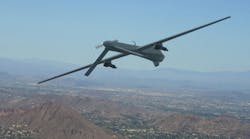Increasing use of unmanned aerial vehicles (UAVs) for defense-related applications is leading to the development of advanced launch and control capabilities, as demonstrated by the Nomad flight vehicle. This vehicle was tested by researchers from the U.S. Naval Research Laboratory (NRL) off of the USS Coronado (LCS 4). It demonstrated new recovery capability by launching multiple vehicles in quick succession, performing flight operations, and then recovering all vehicles sequentially onboard the USS Coronado (see photo).
“Nomad is a low-cost rotary wing vehicle in which researchers can test remote control, autonomous flight control, station keeping, and safe coordinated flight supporting any number of possible future payloads,” explained Steve Tayman, senior aerospace engineer with NRL’s Vehicle Research Section (VRS), as well as co-principal investigator for the research project. “The unique form factor provides compact, light-weight storage in an integrated launch tube, and allows for storage in a ready-to-use condition for quick reaction deployment.” The Nomad experiments were funded by the NRL.
The Nomad was originally developed as an expendable UAV design. This latest version retains the expendable design, but has a recovery feature that allows operators to retrieve and reuse Nomad vehicles multiple times for testing, training, and possible future missions. The Nomad’s launching system originally supported a CO2 ejection system from the launch and storage tube. The new design permits deployment of multiple Nomads in quick succession while retaining the safe CO2 ejection system design.
“During this test, we were able to show multiple Nomads can safely operate in the same airspace and fly in a coordinated fashion,” said Aaron Kahn, a senior guidance, navigation, and control advisor also with NRL’s VRS. “The ability to retrieve Nomads back onboard the ship opens up future opportunities for testing and fleet training with more expensive payloads—an aspect of affordability that can be easily overlooked.”
This integration of unmanned vehicles to a Navy ship indicates the growing use of unmanned systems for defensive purposes. By developing the “reuse” capabilities of formerly “disposable” UAVs, the Navy and NRL are also demonstrating practical design approaches to the latest technologies.


